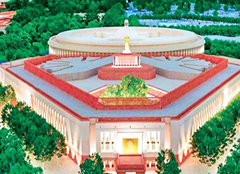

Context
The new Parliament building shows that artworks and its installation represent sanatan parampara and Vastu shastra that continued over thousands of years.
|
Sanatan parampara broadly refers to Hindu culture, which is believed to have been in continuity for centuries. Vaastu shastra is the traditional Indian system of architecture based on ancient texts that describe principles of design, layout, measurements, space arrangement and spatial geometry. |

About the Central Vista Redevelopment Project:
- A 3.2 kilometre stretch in Delhi which includes Rashtrapati Bhawan, Parliament House, North and South Block, India Gate, National Archives among others is ‘Central Vista Project’.
- For the construction of a new parliament building that will be close to the existing one, the Central Vista Redevelopment Project is the government’s plan.
- It includes area covered by central administrative buildings and residential buildings at Raisina Hill, New Delhi, India, which is set under revamping.
|
The planners of the area at which the Parliament was built were Herbert Baker and Edward Lutyens. |
Highlights of ancient Art works model:
- The new building is going to have six entrances exhibit guardian statues showing auspicious animals.
- These “auspicious animals” have been chosen based on their importance in Indian culture, vaastu shastra and traits such as wisdom, victory, power and success.
- Each animal chosen to be installed in the building possesses a set of affirmations, spreading well-being and harmony.
- Importance of Direction:
- The North: Guarding the ceremonial entrance to the north is the gaja (elephant), which represents wisdom, wealth, intellect and memory.
- According to vaastu shastra, the northern direction is associated with Mercury, which is the source of higher intellect.
- The South: The southern entrance is the ashva (horse), which is symbolic of endurance, strength, power and speed — describing the quality of governance.
- The East: Soaring at the eastern entrance is the garuda (eagle), which symbolises the aspirations of the people.
- In vaastu shastra, the east is associated with the rising sun, representing victory.
- The north-eastern entrance: It has hamsa (swan), which represents discernment and wisdom.
- The remaining entrances showcase the makara (a mythical aquatic creature that is a combination of the body parts of different animals), which represents unity in diversity, and the shardula (a mythical animal that is said to be the most powerful of all living beings), which symbolises the power of the people of the country.
- Remains of India’s freedom struggle:
- The new building will have six granite statues devoted to personalities involved in the freedom struggle and making of the Constitution, four galleries each for the two Houses, three ceremonial foyers, as many India galleries and one Constitution gallery.
- Depicting Art and Culture:
- Inside the building, each wall will have a theme reflecting a certain aspect, such as contributions by tribal and women leaders.
- The artworks used indicate the 5000 years old culture of India.
- There will be adequate focus on Indian knowledge traditions, the Bhakti tradition, Indian scientific traditions as well as monuments.


